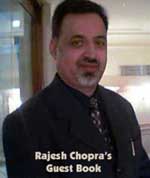| Indian-origin
researchers saucer-shaped aircraft all set to fly
Washington, June 24 (ANI):
An Indian-origin researcher at the University of Florida has revealed that
a new wingless, saucer-shaped aircraft he has made is all set to take to
the skies.
Instead of calling his aircraft
a UFO, Subrata Roy calls it a “wingless electromagnetic air vehicle” (WEAV).
Roy insists that a successful
flight of his aircraft may usher in a new age of aircraft design.
“If this works and we are
able to fly it, this will be a quantum shift in how we see flying objects,”
Discovery News quoted him as saying.
He revealed that the WEAV
would rely on a physical phenomena known as magnetohydrodynamics for its
flight.
He pointed out that a fictional
submarine powered by a magnetohydrodynamic drive in the Sean Connery starrer
film The Hunt For Red October was probably the most widely known example
of the technology.
Roy said that his aircraft
would have different sets of electrodes placed on a thin ceramic plate.
While one set would be located
on the top and bottom of the craft to move ionized air down and provide
lift, the other set would be placed along the sides to propel the aircraft
forward.
According to him, the electrodes
would create a conducting fluid by ionising the surrounding air into plasma.
He said that the force created
by passing an electrical current through this plasma would push around
the surrounding air, and that air would then create lift and provide momentum
and stability to the aircraft.
Anthony Colossa, a researcher
at NASA’s Glenn Research Center who is not involved in Roy’s work, said
that the WEAV would be the first aircraft to fly using magnetohydrodynamics.
He revealed that, eight years
ago, a NASA team once tried to use ionised air propulsion to fly an aircraft
that was attached to an external battery.
“When they first did it they
thought it was miraculous, an anti-gravity machine, all that stuff. Then
they stuck it into a vacuum and it didn’t move,” he said.
Roy said that his aircrafts
first test flight might take place in as little as four months.
He said that if the test
flight turned out to be a success, it would pave the way for larger-scale
versions of the WEAV.
Experts at NASA and the U.S.
Air Force are taking a lot of interest in Roys project.
“We’ve been getting so many
phone calls and emails, you wouldn’t believe it,” said Roy.
|
|
A new wingless, saucer-shaped
aircraft is scheduled to take to the skies - just don't call it a UFO.
Professor Subrata Roy, a
scientist at the University of Florida, calls his aircraft a "wingless
electromagnetic air vehicle," or WEAV, and if it flies he says it could
usher in a new age of aircraft design.
"If this works and we are
able to fly it, this will be a quantum shift in how we see flying objects,"
says Roy.
The WEAV will use a physical
phenomenon known as magnetohydrodynamics - used by Captain Marko Ramius's
submarine in the movie The Hunt For Red October. |
The fictional submarine engine
had no moving or rotating parts. Instead it used a series of electrodes
that ionised the water and pushed it out the back of the submarine, silently
propelling it forward.
Whether a craft moves through
water or air, the principle is the same.
Ionising plates
In Roy's WEAV there will
be two different sets of electrodes placed on a thin ceramic plate. One
set will be located on the top and bottom of the craft to move ionised
air down, providing lift. Another set along the sides to propel the aircraft
forward. The electrodes create a conducting fluid by ionising the surrounding
air into plasma.
The force created by passing
an electrical current through this plasma pushes around the surrounding
air, and that air creates lift and momentum.
While the aircraft has no
moving parts, the craft will spin to provide stability, the same way that
the barrel of a rifle spins a bullet to make it fly straight.
This wouldn't be the first
aircraft to fly using magnetohydrodynamics, says Anthony Colozza, a researcher
at NASA's Glenn Research Center who is not involved in Roy's work.
According to Colozza, about
eight years ago a NASA team used ionised air propulsion to fly an aircraft
that was attached to an external battery.
Not for space travel
"When they first did it
they thought it was miraculous, an anti-gravity machine, all that stuff,"
says Colozza. "Then they stuck it into a vacuum and it didn't move."
The new aircraft needs air
or at least a magnetic field in order to operate. Therefore it wouldn't
work in space or fly between planets, although Roy says it could fly missions
on other planets.
And don't expect the WEAV
to zoom away from earth like the flying saucers in the movies.
"Escaping [earth's] gravity
pool is a different ball game altogether," says Roy.
Roy estimates that the first
test flight could happen in as little as four months. If successful, the
physics of magnetohydrodynamics lend themselves to larger aircraft, making
larger-scale versions of the WEAV possible.
Whether the aircraft actually
flies or not, it is already generating interest. NASA and the US Air Force
have both contacted Roy, and UFO theorists have latched onto the development.
"We've been getting so many
phone calls and emails, you wouldn't believe it," says Roy.
|




